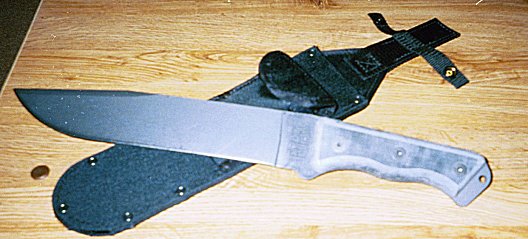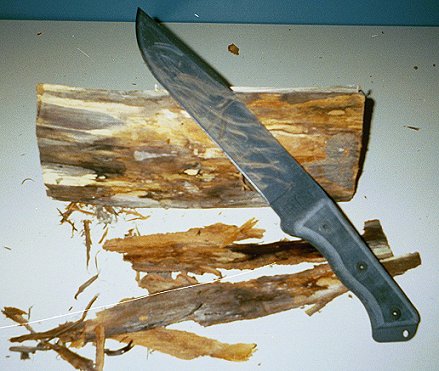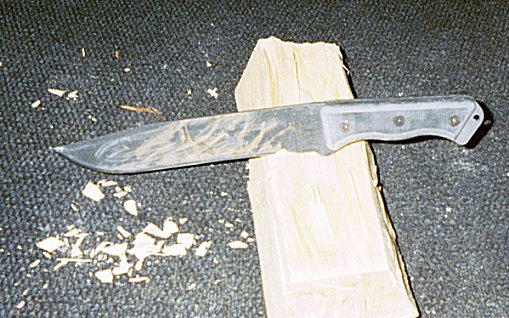its paid sponsors, whose products you need!
| Home |
| Intro |
| Current Issue |
|
Mailing List |
| Store |
| Strength |
| Subscriber Content |
| ARCHIVES
|
| Martialism |
| Pacifism |
| Q & A |
| Cunning-Hammery |
| Advertise With Us |
| Submit An Article |
| Staff |
| Discussion Forum |
| Links |
“Stay ‘unreasonable.’ If you
don’t like the solutions [available to you], come up with your
own.”
Dan Webre
The Martialist does not
constitute legal advice. It is for ENTERTAINMENT
PURPOSES ONLY.
Copyright © 2003-2004 Phil Elmore, all rights
reserved.
Ontario RTAK
By Phil Elmore
The folks at
Randall’s Adventure
Training know what it takes to survive in the wilderness. They designed
the Randall’s Training &
Adventure Knife as a cross between a machete and survival fixed blade, an
attempt to be all things or at least, all important things to the
outdoors-person on the move. Thanks to
Ontario, the RTAK
can be had at a reasonable price for a production blade, making it attainable
to a wide audience of hikers, campers, field personnel, and would-be
adventurers.

This is no small knife. At just over 17 inches
long, with a 10 inch, flat-ground, clip point blade of .1875 inch 1095 carbon
steel, the first thing I thought when I picked up the RTAK was that it is a
small machete. The blade is coated in zinc phosphate to help prevent rust,
which reminded me of the Ontario machetes I own. There is a long, unsharpened
false edge along the back of the blade, giving it a “big bowie” look. Even
unsharpened, that false edge wasn’t something against which I’d want to press
my fingers. It would not take much to make it a cutting edge.
The integral guard and pommel with lanyard hole are simply swells in the
outline of the blade metal. The pommel is too thin to be used for hammering,
but significant enough to be used for blunt breaking and cracking tasks. The
handle consists of a pair of linen micarta slabs, held in place with three
screws. These look like they can be removed easily with a hex key for cleaning
and repair.
The ergonomics and tactile sensation of the handle are excellent. I found the
knife extremely comfortable, both in general handling and in chopping wood.
The micarta is rough enough to provide a firm grip, but smooth enough not to
bite into the hand. The palm swell was perfect for me. I did not find chopping
to be tiring or tough on my hand in any way.
The factory edge was more than sufficient for the cutting tasks I asked of it.
Attacking a helpless split log, I used the RTAK to shave away the remaining
bark with little effort. While the blade became dirty with residue from the
bark, it cleaned up easily and showed little wear.

The knife at first felt blade-heavy to me,
which would make it a natural for chopping. Examining it closer, however, I
realized that I could balance it on my finger right at the guard.
Chopping notches out of the log produced a small storm of chips very quickly.
I could find no damage to the edge when I was done, nor did I manage to damage
the tip of the knife using it to pry out chips of wood from the log’s surface.
Chopping with the RTAK was so much fun that I could have sat there and chipped
my way completely through that log, if only I didn’t have to come back to my
desk and write this article.

The ambidextrous sheath appears to be designed
for lashing to a pack or some sort of rigging, rather than worn on a belt. It
is of extremely heavy black nylon without an internal liner that I can see. I
worried that the RTAK might slice through the edge of the sheath as a result,
but repeated drawing and resheathing of the knife produced no noticeable
damage. I suppose such a design is perfect for hot, humid climates, though I
would still like to see some sort of significant internal liner to protect the
sheath and me from the RTAK’s edge.
There are several lashing holes around the perimeter of the sheath, as well as
the male component of a metal snap on the back of the sheath, suitable for
attachment to a compatible snap on other gear. The generous pouch built into
the front of the sheath has a hook and loop closure.
According to Ontario and the RTAK website, the knife is in service with the
Peruvian Air Force Jungle Survival school, as well as with various military
and drug enforcement personnel worldwide. It’s easy to see why. If you’re
contemplating an adventure of your own, or simply wish to be well prepared on
your next hike, consider the RTAK.
It’s a serious tool that promises serious
performance.
